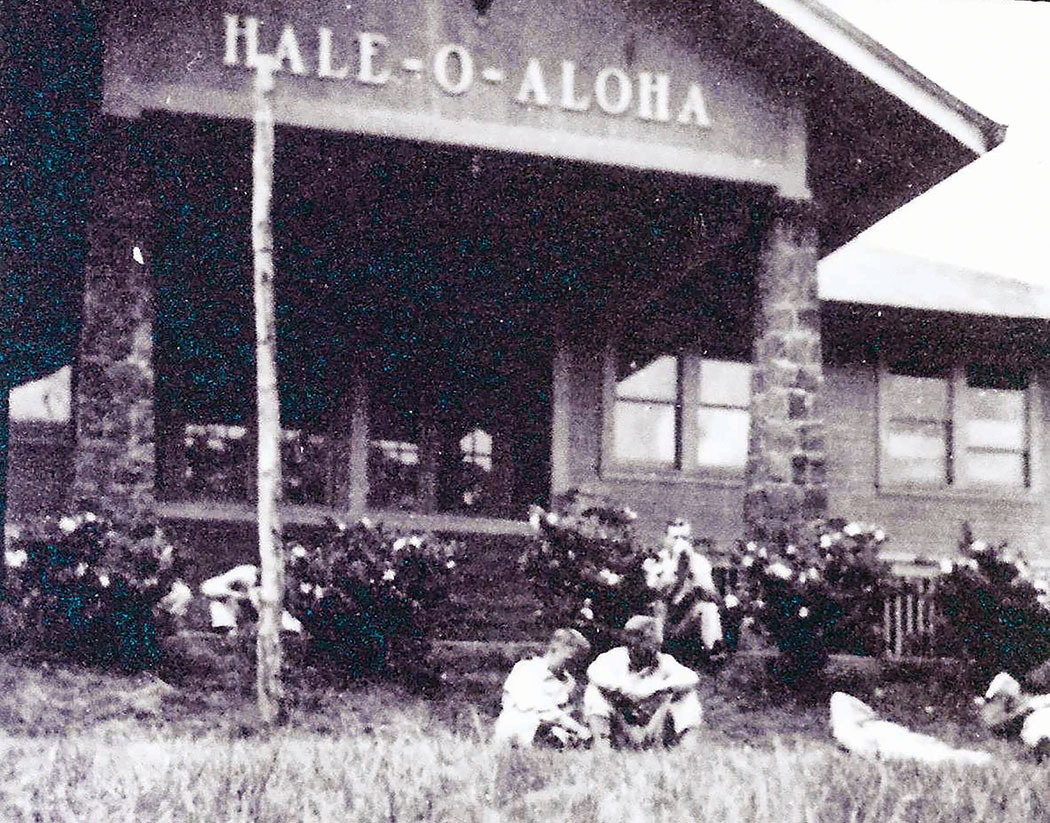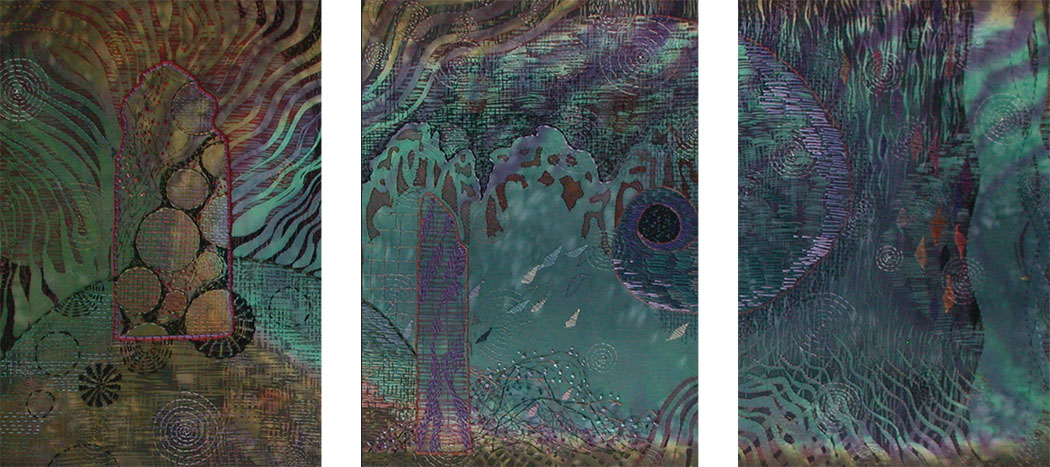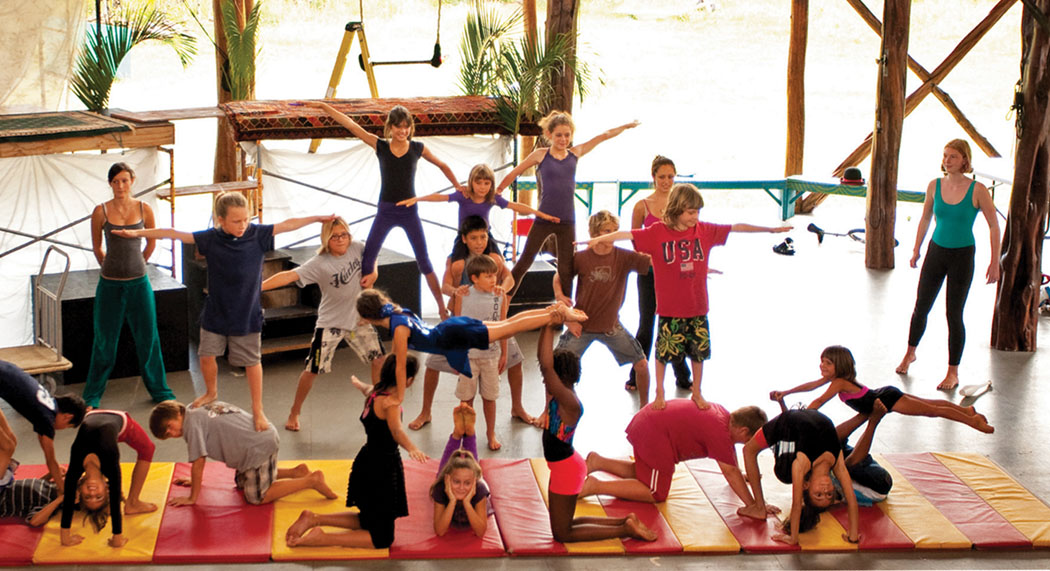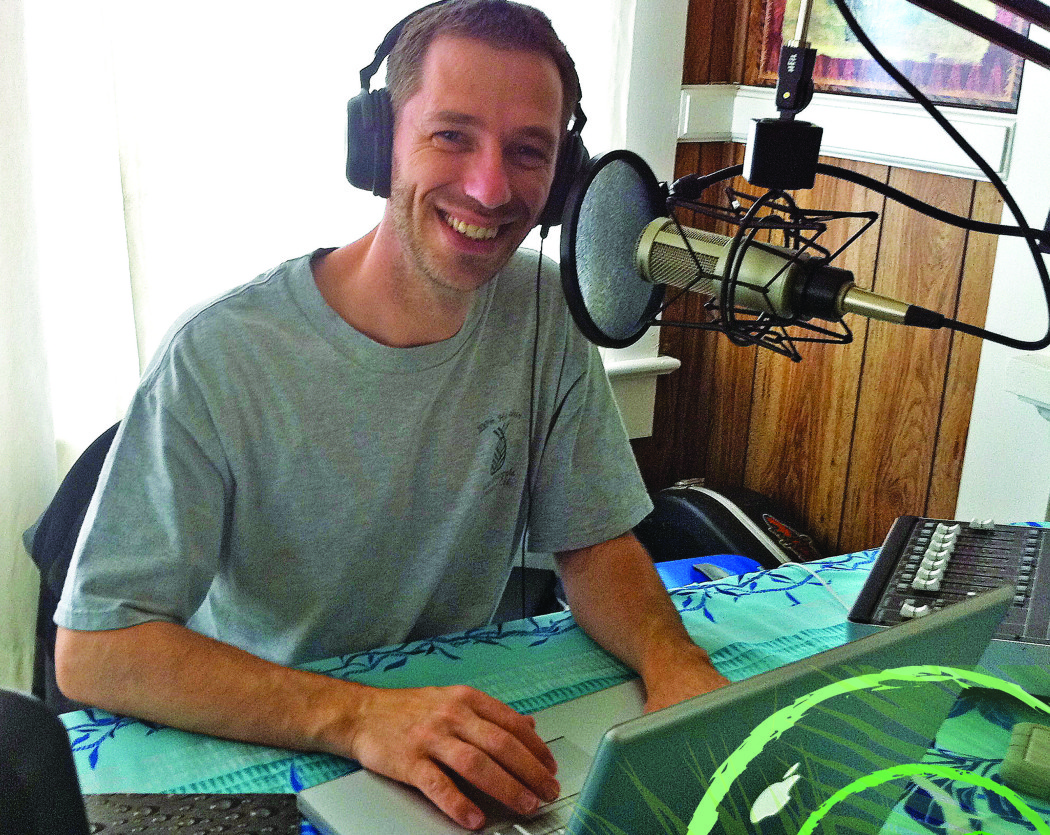
Kaliko Beamer-Trapp: A British Transplant and his Love Affair with ‘Olelo Hawai‘i
 By Alan D. McNarie
By Alan D. McNarie
Kaliko Beamer-Trapp sits with two students in a tiny conference room at the offices of Kahuawaiola, the teacher training and certification program for Hawaiian language immersion schools, in a redwood “temporary building” on the University of Hawai‘i Hilo Campus. Both Beamer-Trapp and the students are speaking entirely in Hawaiian, punctuated with frequent laughter.
Few people could claim to be more immersed in Hawaiian language and culture than Beamer-Trapp. For six years, he taught anthropology, computer graphic arts, French, Marquesan, and aquaculture—all in the Hawaiian language— at Nāwahīokalani‘ōpu‘u Hawaiian Language Immersion School in Kea‘au. Now, in addition to his work at Kahuawaiola, he works as an instructor in Hawaiian at UH and teaches Hawaiian language online while pursuing a masters’ degree in Hawaiian Language and Literature, serving as President of the Mohala Hou Foundation, which works to “promote public understanding and involvement in Hawaiian culture including music, dance, language, material crafts and history” — and he still finds time to perform, occasionally, with other members of the legendary Beamer ‘ohana, one of the first families of Hawaiian music and hula. He’s also served as a Hawaiian language judge at hula competitions.
Surprisingly, when Beamer-Trapp emerges from his student conference and speaks English with a visitor, he does so with a British accent. He was born on another isle — the Isle of Wight, off the southern coast of England — and became a hanai (adopted) member of the Beamer family in a special ceremony in Waipi‘o Valley in 1996.
“I’m not Hawaiian,” says Beamer-Trapp, a slender, relatively young man with close-cropped, dark hair and an infectious smile. “I never will be, and I’m not expecting to be and I don’t want people to think I am, but I love Hawaiian language and culture, and I think it’s just as valuable, it’s just as worthy as any other on Earth today. So it should still have a place in the modern world, and that’s what I’m here to do, is to help that happen.”
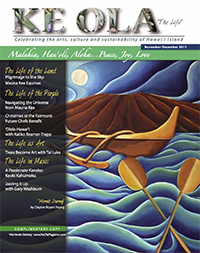
Beamer-Trapp’s odyssey halfway around the world began in 1982, when his parents divorced and he accompanied his mother to a new life in California. Many Americans tend to look at Britain and see all the similarities with themselves, but the young Brit found plenty of culture shock: the language, the culture and the school system, in his eyes, were all “very different,” and not all the change was to his liking. He made a conscious decision to “retain my Englishness,” as he puts it.
“I think that was one of the important realizations that started me on my path to the value of looking at a culture and a language that was particular to a certain people,” he says.
In 1985, he joined a troupe called Dances of the Pacific, founded and led by a kumu named Marge Bronson. The troupe performed a variety of music and dance from around the Pacific, including Tahitian, Tongan, Maori and Hawaiian. Performing with the group he first experienced, indirectly, the influence of the late Winona Kapuailohiamanonokalani Desha Beamer, universally known as “Auntie Nona”: beloved kumu hula, musician, composer, storyteller, author, teacher and cheery advocate of Hawaiian language and culture.
“In the 40s, she [Bronson] was a student of Auntie Nona Beamer in Hawai‘i; therefore, the type of hula she learned was Beamer-style hula, based on the hula style developed and taught by Helen Desha Beamer,” relates Kaliko. “Marge subsequently went back home to California and started teaching Beamer-style hula there, which ended up turning into Dances of the Pacific.”
In 1989, after Bronson had passed away, Dances of the Pacific invited Auntie Nona to California for a tribute performance to her. It was the first time Kaliko met the beloved matriarch of the Beamer clan in person, and it was an event both would long remember.
“That was when I made my first lei. I found some plumeria somewhere, and I presented it to her onstage,” he recalls. Then he went to join the rest of the troupe in their performances.
Auntie Nona would recount what happened next so often that Kaliko can recite her words from memory: “I asked, ‘Who is this young haole boy? He’s out there singing with the Tahitians, dancing with the Tongans, singing with the Hawaiians. I want to know who he is.’”
“We ended up becoming friends just by chatting,” Kaliko recounts. “We stayed in touch by mail. I was trying to write Hawaiian mele, to write Hawaiian poetry and songs.”
But his main focus, at that point, was Tongan culture. He was living with a Tongan family and making a living by working alongside them, building rock walls.
“I got an inside view of Polynesian family life — modern life in California, but Tongan nonetheless. The speech, the mannerisms, the food were all Tongan.…I was hanging out with these people, eating their food, living in their house, and basically sucking up the Tongan lifestyle,’ he remembers. He started to learn the Tongan language, “just by being around these people,” and he liked it.
He also performed with the Tongans on cruise ships, which was how he first got to Hawai‘i. He scoured Honolulu bookstores for a volume on Tongan grammar and he found none. “When you ask speakers of any language to describe the grammar, you’re going to get a blank stare, he remarks. He did, however, find Hawaiian grammar books, which began to lead him in a new direction.
Then, in 1994, “Auntie Nona sent word to her cousin in California to find me and tell me, ‘Kaliko, why don’t you come to Hawai‘i?’” The Beamers requested a $1,000 scholarship from Kamehameha Schools to bring him here to study Hawaiian language and culture, and they got it.
“When I heard that news, I made a plan,” he recalls. “I said, ‘In two weeks, I’m going to be on a plane with all of my stuff and I’m going to be on my way to Hawai‘i.’” He made his deadline, reducing his belongings to eight suitcases and getting them and himself on a plane in May of 1994.
“I kind of came into a black hole, because I didn’t know anybody here,” he remembers. “I didn’t really know where Auntie Nona lived. I didn’t know where Pahoa was.” He met Kapono Beamer and Uncle Keola Beamer when he came to Kamehameha Schools to collect the scholarship. By chance, he found his way to “a meeting put on by OHA [Office of Hawaiian Affairs] at Kamehameha Schools to discuss with community leaders in the Hawaiian language and culture area, how to perpetuate Hawaiian culture in Hawai‘i…I met Kalena Silva, Pila Wilson, Kauanoe Kamana Wilson, Larry Kimura, Kumu John Lake and many others who were very kind to me and invited me to continue my studies. They said to me, ‘Why don’t you come to Hilo to learn the Hawaiian language?’”
Auntie Nona invited him to live at her house. He found out, finally, where Pahoa was.
“She, I suppose, saw some promise,” he says, wonderingly. “Her real life’s goal was to help all people who wanted to learn Hawaiian language and culture — to help them to get there, to help them to do so…to perpetuate Hawaiian culture in all its aspects…. She and I went and did lectures, performances and presentations all over the place. We were performing with Keola Beamer and his wife Moana as well.”
He realized that through the lectures and performances they were doing, Auntie Nona was teaching him about Hawaiian culture in the traditional Hawaiian style.
“Maka hana ka ‘ike,” He Says. “You Learn by Doing.”
Auntie Nona passed away on April 10, 2008. Since then, Kaliko and the rest of the Beamer ‘ohana have devoted themselves to continuing her legacy. The Mohala Hou Foundation that Kaliko heads, for instance, is probably best known for its Aloha Music and Dance Camps in Keauhou, directed by Keola Beamer (Kaliko teaches Hawaiian language and ‘ukulele at the camps). [See Ke Ola magazine, September/October, 2011.] But the foundation also runs a number of other programs. It’s the Hawai‘i affiliate for Guitars in the Classroom, for instance, which brings guitarists to local schools to supplement their often fiscally-beleaguered music curricula. The foundation’s Ho‘oulu (“to stimulate growth”) program focuses on “broad community interaction and bridge-building” through performances and other cultural activities.
And then, of course, there are all of Kaliko’s other teaching activities; in addition to his work with the university and Kahuawaiola, he runs an online Hawaiian language classroom called ‘Olelo Online (www.oleloonline.com).
“I love teaching Hawaiian language,” he says. “I have lots of great students, and I try to remind myself all the time of what Auntie Nona taught me, especially her teaching techniques — how to show love and aloha as you teach, and how to teach in general.
“She really refined how to teach Hawaiian culture….What Auntie Nona has done for so many people was that she gave so many people encouragement in their desire to learn Hawaiian language and music and culture.
“I’m just another one of those many people. I must give my credit to her.” ❖
Contact writer Alan McNarie at amcnarie@yahoo.com.
‘Ōlelo Online – Kaliko’s online Hawaiian language lessons: www.oleloonline.com
Mohala Hou Foundation: www.mohalahou.org
